This sample Fingerprint Identification Research Paper is published for educational and informational purposes only. If you need help writing your assignment, please use our research paper writing service and buy a paper on any topic at affordable price. Also check our tips on how to write a research paper, see the lists of criminal justice research paper topics, and browse research paper examples.
Overview
This research paper will provide an overview of the stages leading to fingerprint identification, including the enhancement of marks deposited at crime scenes, obtaining images of the enhanced marks that are suitable for identification, and the methodologies that are used during the identification process itself. The range of enhancement processes that can be used to reveal marks is described in detail, showing how different constituents of deposited marks can be progressively targeted to maximize the number of marks recovered. This research paper also addresses some of the recent research associated with the fingerprint identification stage, including the possible influences of cognitive bias and the use of probabilistic approaches to describe fingerprint identifications in place of 100 % certainty.
Fundamentals
Definitions
In this section, the term “fingerprint” will be used to describe impressions of the ridge patterns on fingertips that have been taken under controlled conditions, for example, inked or digitally enrolled ten-print sets. The term “finger mark” is used to describe the marks recovered from articles or surfaces at crime scenes.
“Finger mark recovery” is defined as the process by which finger marks present on articles and surfaces are revealed and captured. The output of the finger mark recovery process is an image of the mark that can be submitted for comparison and identification.
“Fingerprint identification” is defined as the comparison of finger marks against sets of fingerprints, or two sets of fingerprints against each other, so that it can be established that they originate from a common source.
Finger Mark Recovery
Introduction
The finger mark recovery process begins with an initial examination of an article or surface where it is suspected that finger marks may be present. In some cases marks may already be visible during the initial examination, either because they have been deposited in a visible contaminant (“patent” marks) or because they have left permanent impressions in a soft surface (“plastic” marks). The majority of marks present on the surface are not visible during this initial examination, and some means of enhancement will be required to make them detectable by an eye or an imaging system. These marks are known as “latent” marks.
One of the principal differences between finger marks and other types of forensic evidence is the wide range of mark enhancement techniques that are available, and the fact that it is possible to use several of these techniques in sequence. The sequential application of enhancement techniques, commencing with nondestructive processes and progressing to techniques directly reacting with constituents of the mark, maximizes the chances of their recovery.
A wide range of optical, physical, and chemical techniques are available for the detection and enhancement of latent finger marks. The choice of the best sequence of techniques will depend on several factors that include the following:
- The nature of the surface and the presence of any particular contaminants
- Environmental factors
- The likely age of any evidential finger marks
- Investigative priorities
- Other forensic evidence
The techniques that are used for finger mark enhancement all have the same purpose, which is to increase the contrast between the finger mark ridges and the surface they have been deposited on to an extent where the mark can be readily seen and captured. Many different properties of the mark may be used to achieve this contrast, including optical properties, adhesive properties, chemistry of the mark, and electrical properties. The chemistry of finger marks is usually a complex one, and the chemicals that may be present in marks include constituents of eccrine, sebaceous, and possibly apocrine sweat, contaminants from any substances handled, and substances significant at crime scenes such as blood. If additional information can be obtained about the likely composition of the finger marks (e.g., contaminants that may be present), this will assist in the selection of the most appropriate enhancement techniques.
When considering which enhancement techniques should be applied to a particular article or surface, the nature of the surface and the environment it has been exposed to should also be considered. Surface characteristics such as porosity, texture, and color will all influence what happens to the mark post-deposition and, thus, will influence the selection of the most appropriate technique(s). This will be equally true of any known environmental conditions such as exposure to water and high temperatures. The initial examination stage should be used to obtain as much of this information as possible so that the selection of enhancement processes is optimized.
Finger Mark Enhancement Techniques
The sections below give an overview of some of the finger mark enhancement processes that are available, together with some indication of their potential applications. Many other processes have been reported, those outlined below cover a representative range.
Nondestructive Processes
Visual Examination Visual examination utilizes differences between the optical properties of the mark and the surface to provide contrast. The surface is illuminated with a light source, and the angle and proximity of the light source to the surface varied until optimal contrast is obtained. The process is most suited for greasy marks and marks in dust on nonporous surfaces.
Fluorescence Examination Fluorescence examination is performed by illuminating the surface with a high intensity light source and viewing any fluorescence through a filter that blocks the illuminating wavelength range (Menzel 1999). It can be used to detect latent finger marks on both porous and nonporous surfaces, or to enhance marks developed using other techniques. Contrast is obtained by either the mark or the background fluorescing, and the other component absorbing the incident light. When used to detect latent marks, any fluorescence observed in the mark is most likely to arise from the presence of contaminants although some natural constituents may fluoresce.
Ultraviolet Imaging Ultraviolet imaging is a specialized technique that requires an imaging system sensitive to short wave ultraviolet radiation. The surface is irradiated with short wave ultraviolet, and the outcome is viewed through the imaging system. On porous surfaces, marks may absorb radiation and the surface may reflect it, and on nonporous surfaces marks scatter radiation to a greater extent than the surface (Creer 1995). Both mechanisms may give sufficient contrast for the marks to be revealed. The short wavelength of the ultraviolet radiation is scattered more than visible wavelengths, meaning that fainter traces of marks can be detected. The technique should be used with caution because short wave ultraviolet is harmful to both skin and eyes, and can destroy DNA evidence.
Selective Deposition Processes
Powders Powdering is one of the oldest finger mark enhancement techniques. Finely divided powders are applied to the surface using a brush (or an equivalent delivery system such as a magnetic applicator), and some of the particles selectively adhere to the ridges of the mark, making it visible (Fig. 1). A variety of adhesive mechanisms may operate, including wetting by capillary action and physical adhesion due to the “sticky” nature of the mark. A wide range of powder types are available, and the most appropriate should be selected taking into account factors including the surface texture and color.
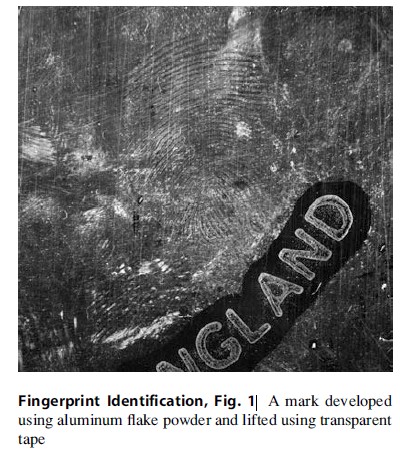 Fingerprint Identification, Fig. 1 A mark developed using aluminum flake powder and lifted using transparent tape
Fingerprint Identification, Fig. 1 A mark developed using aluminum flake powder and lifted using transparent tape
Small Particle Reagent Small particle reagent formulations utilize a dilute mixture of particulates (most commonly molybdenum disulphide) in a water/detergent solution. The detergent molecules form micelles around the particles, the lipophilic molecules in the micelles causing the particles to preferentially attach to the lipids in the mark. The article being treated is immersed in an agitated solution of the small particle reagent, and the particles are allowed to settle onto the article. Excess particulates are gently washed from the surface to reveal the mark. The technique is suited for use on nonporous surfaces and can be used on articles known to have been wetted.
Powder Suspensions Powder suspensions are very similar in nature to small particle reagent, but consist of a much more concentrated mixture of powder (either carbon, iron oxide, or titanium dioxide) in a detergent/water mixture. This is painted onto the surface using a brush and then washed off before it can dry. Some constituent of the mark (thought to be eccrine constituents held in an insoluble matrix) destabilizes the micelles and causes particles to preferentially settle on the ridges. The technique can be used on nonporous surfaces, adhesive surfaces (Bratton and Gregus1997), and semi-porous surfaces, including those that have been wetted (Fig. 2).
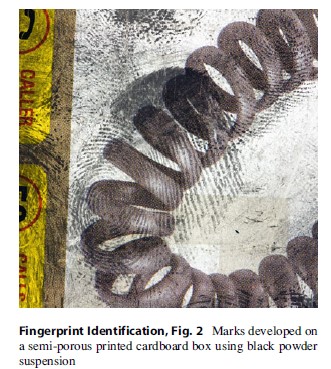 Fingerprint Identification, Fig. 2 Marks developed on a semi-porous printed cardboard box using black powder suspension
Fingerprint Identification, Fig. 2 Marks developed on a semi-porous printed cardboard box using black powder suspension
Vacuum Metal Deposition Vacuum metal deposition reveals marks by selective deposition of metal onto the surface. Vacuum is required to reduce the metal vapor pressure to a point where it can be readily evaporated. The most commonly used process involves an initial evaporation of a small quantity of gold, which deposits all over the surface as small clusters. The size and distribution of these clusters is influenced by the nature of the surface, and often differs between the ridges and the background. A second evaporation of zinc is then conducted, zinc relying on the presence of gold clusters to initiate and grow as a film on the surface. Differences between the growth rate of zinc on the ridges and background regions make the marks visible (Kent et al. 1976). Vacuum metal deposition is most suited to nonporous surfaces but can also be used on semi-porous and porous surfaces including fabrics. It can be used to develop marks on nonporous surfaces that have been wetted (Fig. 3).
Multimetal Deposition Multimetal deposition is a liquid phase deposition process. The article is first exposed to an acidified colloidal gold solution. This causes constituents of the finger mark ridges to become charged, and colloidal particles are attracted by and bound to the mark. This is not sufficient for the mark to become visible, so the article is exposed to a second “physical developer” solution consisting of a silver-iron redox combination. Silver particles are preferentially deposited on the gold already bound to the ridges, and the mark becomes visible as a consequence (Schnetz and Margot 2001). Multimetal deposition can theoretically be applied to both nonporous and porous surfaces but in practice is most suited to nonporous surfaces, in particular plasticized polymers such as “cling film.”
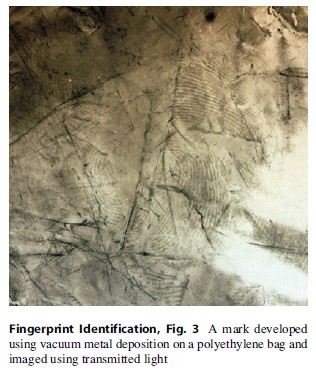 Fingerprint Identification, Fig. 3 A mark developed using vacuum metal deposition on a polyethylene bag and imaged using transmitted light
Fingerprint Identification, Fig. 3 A mark developed using vacuum metal deposition on a polyethylene bag and imaged using transmitted light
Cyanoacrylate Fuming Cyanoacrylate fuming reveals marks by selective polymerization of cyanoacrylate monomer vapor on finger mark ridges. Vapor can be produced in several ways, but is most commonly achieved by evaporation of liquid cyanoacrylate monomer from a dish placed on a heated stage. The resultant polycyanoacrylate deposit appears white and may give sufficient contrast for marks to be seen on dark surfaces. However, subsequent enhancement techniques are often used to increase contrast, such as staining the polymer deposit with fluorescent dyes (Fig. 4). The polymerization reaction is initiated and catalyzed by the presence of finger mark constituents including salts (especially sodium chloride) and some other eccrine constituents in the presence of moisture (Wargacki et al. 2007). Fuming cabinets may be humidified to supply this moisture in a controlled manner. Cyanoacrylate fuming is generally used on nonporous surfaces, but is not suitable for use on wetted surfaces because the eccrine constituents that initiate polymerization are dissolved.
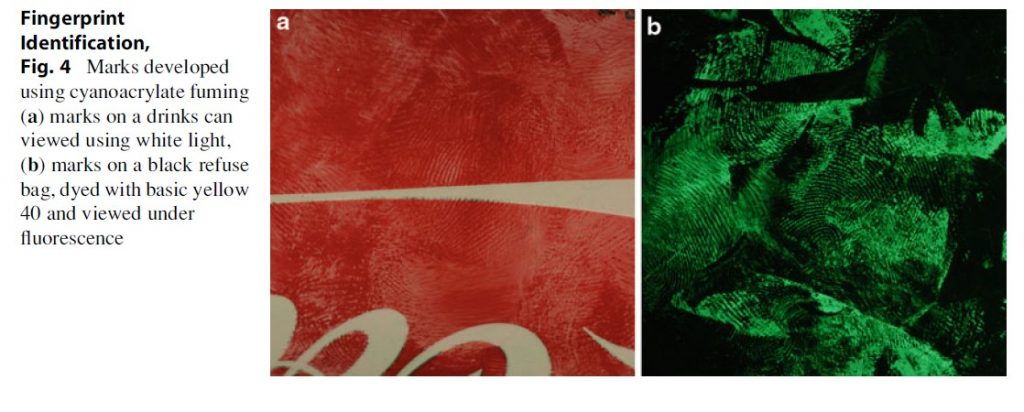 Fingerprint Identification, Fig. 4 Marks developed using cyanoacrylate fuming (a) marks on a drinks can viewed using white light, (b) marks on a black refuse bag, dyed with basic yellow 40 and viewed under fluorescence
Fingerprint Identification, Fig. 4 Marks developed using cyanoacrylate fuming (a) marks on a drinks can viewed using white light, (b) marks on a black refuse bag, dyed with basic yellow 40 and viewed under fluorescence
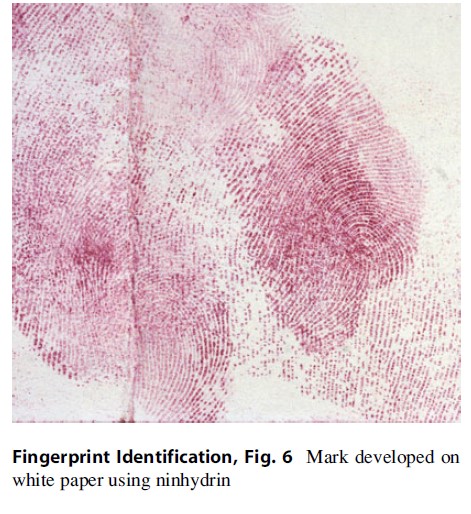 Fingerprint Identification, Fig. 5 Marks developed on adhesive tape using basic violet 3 (a) viewed using white light, (b) viewed under fluorescence
Fingerprint Identification, Fig. 5 Marks developed on adhesive tape using basic violet 3 (a) viewed using white light, (b) viewed under fluorescence
Staining Reagents
Basic Violet 3 Basic violet 3 is a dye that can be used to preferentially stain lipids, greasy contaminants, and epithelial cells sometimes shed within finger marks (especially on adhesive tapes). The dye molecules preferentially transfer from solution into any compatible constituents that may be present within the mark, staining them violet. Excess dye is then washed from the surface. The dye is also fluorescent and marks that are not stained sufficiently for them to be detected visually may become visible when examined using fluorescence. Basic violet 3 can be used on surfaces contaminated with grease, and on nonporous and adhesive surfaces. On nonporous and adhesive surfaces, it is generally used last in a sequence because it may cause heavy staining, but is capable of developing reasonable numbers of additional marks. The dye and solvents used do have health and safety issues associated with them and use should be restricted to small articles under controlled conditions (Fig. 5).
Solvent Black 3 Solvent black 3 is another dye that is used to selectively stain the lipid constituents of finger marks together with greasy contaminants. The article being treated is exposed to the dye solution until staining has occurred and then the excess washed from the surface, leaving the marks stained a deep blue/black. Its operational use tends to be confined to nonporous articles known to be contaminated with grease or drinks residue. It is nonfluorescent and nontoxic, although difficult to clean from scenes.
Amino Acid Reagents
Ninhydrin Ninhydrin is one of the mostly widely used finger mark enhancement techniques worldwide. It is most suited for use on paper articles but can be effective on other porous surfaces including matt painted walls and untreated wood. Ninhydrin is an amino acid reagent and reacts with the amino acids present in finger marks to give a purple reaction product (Oden and von Hofsten 1954). The surface or article to be treated is exposed to the ninhydrin solution by dipping or brushing, and is then allowed to dry. Small articles can then be exposed to elevated temperature (~80°C) and humidity (~65 % relative humidity) which accelerates the reaction so that the product is visible in <10 min (Fig. 6). When ninhydrin is applied to large areas such as walls, this is not possible and marks are then allowed to develop at room temperature, which may take over a week.
1,8 Diazofluoren-9-one (DFO) DFO is another amino acid reagent, although in this case the reaction product formed between amino acids and DFO is fluorescent and fluorescence examination is required to visualize the marks (Pounds et al. 1990). Illumination in the green region of the spectrum is required, and the fluorescent marks appear orange (Fig. 7). DFO is more sensitive to ninhydrin, detecting lower concentrations of amino acids, but is less widely used because of the additional time taken to detect marks. DFO is applied in a similar way to ninhydrin, that is, by brushing or dipping, and exposure to temperatures >100°C is required to develop marks in a reasonable time (20 min at 100°C). For this reason, DFO cannot easily be used at scenes. DFO can be used in a sequential treatment routine before ninhydrin, which may develop additional marks when used after it.
 Fingerprint Identification, Fig. 6 Mark developed on white paper using ninhydrin
Fingerprint Identification, Fig. 6 Mark developed on white paper using ninhydrin
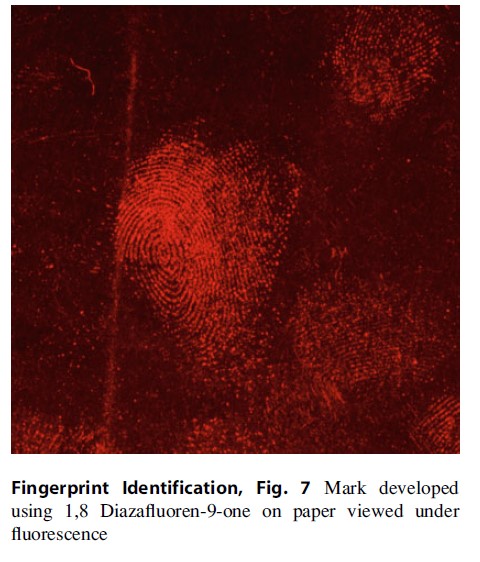
Fingerprint Identification, Fig. 7 Mark developed using 1,8 Diazafluoren-9-one on paper viewed under fluorescence
1,2 Indandione 1,2 Indandione is a more recently introduced amino acid reagent which is displacing DFO from some applications. The is now general consensus that 1,2 Indandione develops more, intensely fluorescent marks than DFO, but it has still not be determined whether the DFO-ninhydrin sequence remains more effective than a sequence of 1,2 Indandione-ninhydrin. 1,2 Indandione is applied and processed in the same way as DFO. Bright pink visible marks are occasionally developed, but the reagent is most effective in fluorescence mode where it is illuminated with green light and produces a yellow-orange fluorescence (Hauze et al. 1998).
Chloride Reagents
Silver Nitrate Silver nitrate is a long recognized enhancement chemical that targets the chlorides present in finger marks and is most suited to use on porous surfaces. A solution of silver nitrate is applied to the surface, which is then allowed to dry in the dark. The dried surface is then exposed to light (with ultraviolet giving most rapid development), and a reaction occurs which first converts to chlorides to silver chloride, and ultimately to silver. Developed marks appear dark brown and darken to gray/black with time. A disadvantage of the technique is that the background also progressively darkens and will ultimately obscure the marks. In common with the amino acid reagents, silver nitrate cannot be used on wetted surfaces because these constituents are water soluble.
Other Processes for Porous Surfaces
Physical Developer Physical developer is the most widely used reagent for porous surfaces that have been wetted. It consists of an unstable silver-iron redox solution, which certain constituents in the finger mark (thought to be eccrine constituents bound in an insoluble matrix) can locally destabilize resulting in the precipitation and growth of fine silver particles on the ridges. Because certain alkali fillers added to paper can also cause precipitation of silver, the paper is first immersed in a weak acid bath until all reaction with these fillers ceases, then immersed in the physical developer solution (Ramotowski 2000). The technique can develop addition marks if used sequentially after DFO and ninhydrin. It can also be used on other porous surfaces such as raw wood.
Oil Red O Oil Red O is a lipid stain that has been proposed for use on porous surfaces such as paper, in particular those that have been wetted. The article to be treated is immersed in a solution of Oil Red O until strong staining of the mark is achieved. This may take up to 90 min. The article is then transferred to a buffer solution, which stops the staining action and removes excess dye from the background (Beaudoin 2004). Because the process targets different constituents of the mark from DFO and ninhydrin, it can potentially be used in sequence after them and before physical developer. However, the lipids most strongly stained by Oil Red O break down with time and the effectiveness of the technique is significantly reduced on marks over 4 weeks old.
Iodine Iodine is possibly the oldest reported chemical enhancement technique for finger marks. The traditional means of applying iodine is as a fuming process, enclosing the article to be treated in a chamber with fumes of elemental iodine. The iodine fumes are preferentially adsorbed into the ridges of the mark, staining them a brown color. This coloration will gradually disappear unless a fixing agent is applied, the most commonly used being a solution of a-napthoflavone which stains the developed mark blue. Iodine can also be applied as a solution, with the fixing agent incorporated into the formulation. Blue marks are rapidly developed as the solution evaporates from the surface. Iodine is most commonly used on porous surfaces but can also be applied to nonporous surfaces, including those contaminated with grease. The principal constituent of natural secretions targeted by iodine is squalene, which is rapidly lost from the finger mark. As a consequence, iodine tends to be ineffective on marks more than a few days old.
Blood Dyes The reagents used to enhance marks in blood fall into two principal categories, protein stains that selectively stain the proteinaceous constituents of blood, and reactive dyes that are catalyzed by the heme constituent. Both types of dyes are outlined below.
Acid Dyes Acid dyes operate by selectively staining the proteins present in blood. They require the blood to be first fixed, either by the application of heat, drying using methanol, or application of a fixing agent such as 5-sulphosalicyclic acid. Once the mark has been fixed, a staining solution containing the dye is applied, and the dye molecules become selectively bound to the proteins giving them a strong coloration. The excess dye is then washed from the surface using a destaining solution. A range of acid dyes have been used for this purpose, including acid black 1, acid violet 17, acid violet 19, and acid yellow 7 (Sears et al. 2005). All of these dyes are suitable for use on nonporous surfaces and most are suitable for nonporous surfaces although some dyes (e.g., acid yellow 7) cannot be easily washed from the background (Fig. 8).
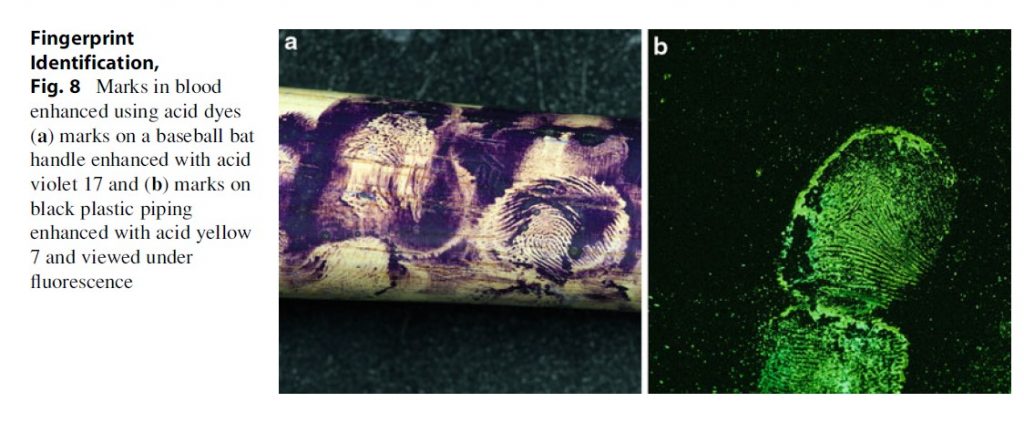 Fingerprint Identification, Fig. 8 Marks in blood enhanced using acid dyes (a) marks on a baseball bat handle enhanced with acid violet 17 and (b) marks on black plastic piping enhanced with acid yellow 7 and viewed under fluorescence
Fingerprint Identification, Fig. 8 Marks in blood enhanced using acid dyes (a) marks on a baseball bat handle enhanced with acid violet 17 and (b) marks on black plastic piping enhanced with acid yellow 7 and viewed under fluorescence
Leuco Dyes Leuco dyes are the principal type of reactive dye that is used for enhancement of marks in blood. They are made into solutions in their colorless form, and when applied to marks in blood a reaction is catalyzed by the heme molecule which results in the formation of the colored form of the compound, thus making the mark visible. The two dyes most commonly used for this purpose are leuco crystal violet, which stains marks violet, and leuco-malachite green, which stains marks a green-blue. The reagents are most commonly applied in the form of a fine spray and are more suited to speculatively searching for marks in blood than the acid dyes.
Because there is more protein than heme present in blood, the acid dyes are expected to be more sensitive in this application. However, both types of reagents may give false-positive reactions with certain substances.
Enhancement Of Developed Marks
Once marks have been enhanced, there may be sufficient contrast for them to be easily imaged. If this is not the case, then it may be possible to apply filtration or use more advanced imaging processes to make the mark sufficiently visible for imaging. Some of the means by which this can be achieved are described below.
Color Contrast Filtration If the mark is difficult to visualize, and either the mark or the background is colored, it may be possible to use colored filters (or a colored light source) to increase the contrast between the mark and the background. Where the mark is colored, but too faint to distinguish from the background, a filter of contrasting color can be used to increase visibility of the ridges. An example of this is the green filter sometimes used to improve the contrast of marks developed using ninhydrin. Color contrast filters can also be used to improve visibility of marks developed on light-colored surfaces using enhancement techniques such as white powder suspensions. In this case, the contrast filter darkens the background and the mark remains light.
Infrared Imaging Infrared imaging can be considered in cases where developed marks are obscured by patterned and/or multicolored backgrounds. Marks developed using a metallic or inorganic deposition process (e.g., powders, powder suspensions, physical developer) will remain visible when viewed in the infrared region of the spectrum, whereas many backgrounds printed in inks based on organic compounds become transparent. As a consequence, the effect of the background is suppressed, and the mark can be clearly seen. This technique requires an imaging system that is sensitive in the infrared region of the spectrum, a long pass filter blocking visible wavelengths and transmitting infrared placed in front of the imaging system, and a light source with significant intensity of output in the infrared.
Imaging Of Developed Marks
Once marks have been enhanced sufficiently for ridge detail to be visible, and it is considered that sufficient ridge detail is present for a potential identification, it becomes necessary to capture an image of the mark.
To meet the requirements for fingerprint identification, it is essential that any image taken provides identification experts with all the information necessary to make decisions on identification/exclusion. The image of the mark should therefore ideally contain all features of significance captured at a resolution appropriate to that feature type, and have clear distinction between what constitutes a fingerprint ridge and what constitutes “background.”
Imaging was traditionally carried out using film photography, although this has now almost entirely been replaced by digital imaging in many countries. Cameras and other digital imaging equipment such as scanners may be used for image capture. Alternatively, for marks developed using powders, a “lift” taken from the surface may occasionally be submitted to the bureau as the “image.”
Digital images can be enhanced post-capture using image processing tools. If this is to be carried out before the image is submitted to the bureau, it is essential that a “master copy” of the originally captured image is retained, together with an audit trail of the modifications that have been carried out to the image submitted for identification.
The output of the finger mark recovery process is therefore an image of the mark that is submitted for comparison with fingerprints taken from suspects. This image may be in the form of an electronic image viewed on screen, a photograph printed from a negative, an image printed on a digital printer, or a physical lift from a powdered mark. In all cases, the identification specialist receiving the image should be given as much information as possible about the mark, including the location and surface it has been developed on, the technique(s) that have been used to enhance it, any modifications that have been made to the image, and any methods used to produce a hard copy. This information will all assist in the subsequent comparison and identification process, which is outlined in the following sections.
Future Trends In Finger Mark Recovery
There is a continued drive to increase the number of finger marks that are recovered from articles, whether it be to identify the optimum technique for “low yield” surfaces such as cling film and fabrics, or to investigate novel chemistries that can interact with constituents of the mark that are not currently targeted. Of particular note is ongoing research using nanoparticles, which can be chemically modified to attach themselves to specific finger mark constituents or suspect contaminants such as drug metabolites.
The compositional analysis of finger marks using advanced analytical techniques such as matrix-assisted laser desorption/ionization (MALDI) and attenuated total reflection Fourier transform infrared spectroscopy (ATR-FTIR) is also generating much interest, as this may offer a means of providing additional contextual information about the donor of a mark. Information that it may be possible to obtain includes the sex of the donor, the approximate age of the mark, and what the donor may have been handling (e.g., drugs or explosives). For these techniques to be truly effective, they will need to be integrated with conventional development techniques.
Fingerprint Identification
Introduction
The premise of fingerprint identification is that the fingerprints of each individual are unique and are persistent throughout their lifetime. It is therefore possible to identify an individual by comparing marks deposited at crime scenes with sets of prints obtained under controlled conditions. By finding sufficiency of agreement between the mark and the corresponding print, and an absence of any unexplained differences, identification is deemed possible. Although it is true that no two individuals have ever been found with the same fingerprints, the marks left at scenes often present partial, smudged, and distorted representations of the fingertip, and therefore, the role of the latent print examiner is to satisfy themselves that there is sufficient information present in the mark to individualize.
The fingerprints found on the tips of each finger consist of patterns formed by ridges in the surface of the skin. These were traditionally grouped into three general types of pattern, the whorl (where the central ridges complete a full revolution), the loop (where ridges enter at one side of the finger, curve back on themselves without touching, then exit at the same side), and arches (where ridges run from one side of the finger to the other without any backward turn). In practice, there are subdivisions of each pattern type, and other more complex pattern types may be found (Fig. 9).
Latent print examiners should assess holistically all features within a fingerprint from which to make conclusions as to identity. These features are broken down into three levels of detail. Level one refers to the basic pattern of the print outlined above, level two refers to the Galton details that consist of discontinuities in the ridge flow, and level three refers to the configuration of sweat pores and shapes of the ridge edges (edgeoscopy and poroscopy) (Fig. 10).
Under a magnifying glass, friction ridges are not uniform in configuration, nor do they necessarily flow in predictable direction or flow. Friction ridge skin has breaks and interruptions within the structure known as Galton details (Galton 1892; Ashbaugh 1999), also known as ridge characteristics or minutiae.
It is these characteristics that, when visible to the examiner, provide the principal means to make a determination of individualization for a latent crime scene finger mark against a suspect’s ten-print card. There are two primary classifications of the characteristics, namely, ridge endings (A), where ridges stop abruptly, and bifurcations, where a ridge divides into two (B) (Fig. 11).
In this instance, the ridges running parallel to this feature diverge to accommodate the ridge division. There are variations of these primary characteristics. For example, a lake is where two bifurcations join together (C); an independent ridge is a short ridge that is divorced from any other ridge (D). A spur (E) is a combination of a small independent ridge and a bifurcation and a crossover (F) as the name suggests is a small ridge joined at each end to two parallel ridges.
Every feature and characteristic in friction ridge skin is readily identifiable and identification can be made so long as there are sufficient characteristics of acceptable quality present. It is possible to match very small amounts of friction ridge skin from a crime scene mark against the prints of a suspect, so long as there is sufficient clarity upon which to rely upon the permanence and reproducibility of visible features.
Identification Methodologies
When comparing detail between a crime scene mark and a ten-print exemplar, a generic methodology has been adopted known as ACE-V (Ashbaugh 1999). In order to make a value judgment on any identification, the examiner must first assess (or analyze) the friction ridge detail in the scene mark so that useful reference points can be identified in the next phase. Next, there must be a comparison of the mark features with that of features within the reference print. Then there must be an evaluation of the findings, from which conclusions as to identity must be derived. Finally, as in all scientific methods, there must be an element of peer review, known as verification, to repeat the ACE process independently to arrive at the same conclusions as that of a colleague.
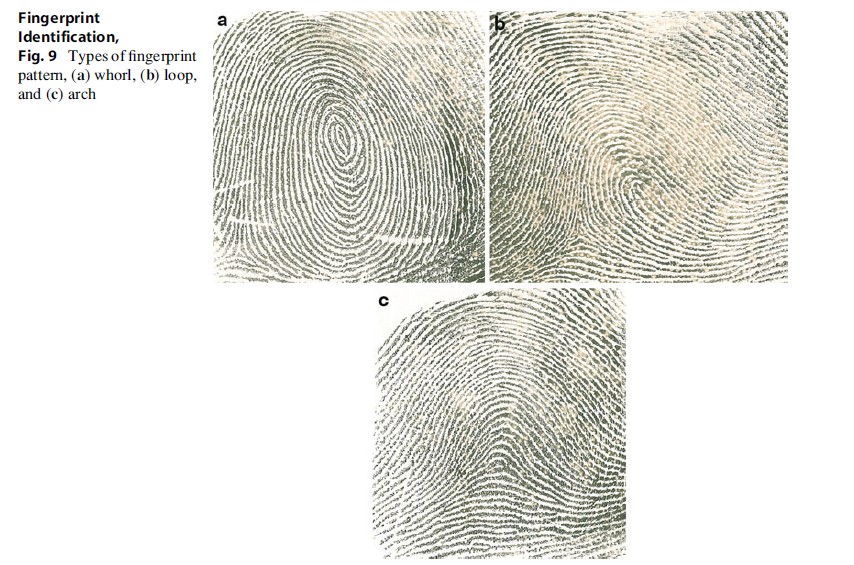 Fingerprint Identification, Fig. 9 Types of fingerprint pattern, (a) whorl, (b) loop, and (c) arch
Fingerprint Identification, Fig. 9 Types of fingerprint pattern, (a) whorl, (b) loop, and (c) arch
During the Assessment (or Analysis) phase, the fingerprint examiner will look for the following:
- Distortion
- Development methods and medium used to visualize latent material (chemicals and powders, etc.)
- Deposition pressure to highlight areas of possible distortion
- Anatomical attributes (features)
- Clarity
During the Comparison phase, the examiner will look for similarities in the following:
- Pattern
- Ridge path
- Ridge shape
- Pore positioning
During the Evaluation, the examiner will look to form an opinion in the following:
- Can the mark be eliminated?
- Is there sufficient information available to individualize?
During Verification, an independent assessment of the casework is undertaken to see whether the ACE process has been correctly executed and that the conclusions reached are consistent with the original findings. In the UK, for a crime scene mark to be identified, the comparison must be undertaken three times. One check will be made by the original examiner, then verification by two further experts who must come to the same conclusions independently.
In some countries, there are a minimum number of features that must be found in agreement between the crime scene mark and the print for the identification to be confirmed. For example, in many European countries there is a requirement for 12 features to be found in agreement with none in unexplained disagreement for an identification to be confirmed. In other parts of the world, including the USA and the UK, there is no longer any “standard,” and it is the responsibility of the examiner to satisfy themselves that the holistic information present justifies the decision that is made.
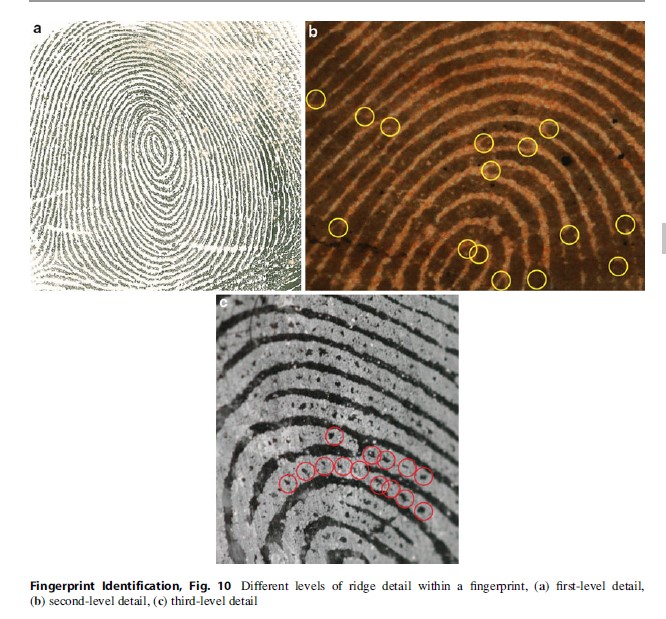 Fingerprint Identification, Fig. 10 Different levels of ridge detail within a fingerprint, (a) first-level detail, (b) second-level detail, (c) third-level detail
Fingerprint Identification, Fig. 10 Different levels of ridge detail within a fingerprint, (a) first-level detail, (b) second-level detail, (c) third-level detail
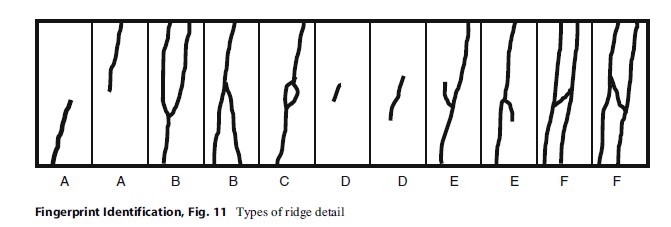 Fingerprint Identification, Fig. 11 Types of ridge detail
Fingerprint Identification, Fig. 11 Types of ridge detail
Automated Fingerprint Identification Systems
The role of automated fingerprint identification systems (AFIS) in the identification process is to provide the identification expert with a selection of candidate prints against which to compare the crime scene mark. It does not replace human opinion in the decision-making process. The algorithms used in AFIS convert images of fingerprints to wire drawings, identify the positions of level two features such as bifurcations and ridge endings, and store information relating to these locations and their spatial relationship to each other.
When a crime scene mark is input into an automated system, it is possible to “auto-encode” it, by allowing the database algorithms to go through the same conversion process and automatically mark the estimated position of ridge endings and bifurcations. In practice an expert will generally review this encoding and locate the positions of these level two features manually, removing any false features such as scratches in the image. The marked positions and spatial relationships of the level two features are then searched against those of the prints in the database, which displays the images associated with the most closely matching feature sets.
The examiner can then review the displayed images to select those that most closely correspond with the crime scene mark, and subject these prints to greater scrutiny in the ACE-V process. The human interpretation of the mark and print therefore remains essential to the decision-making process.
Scientific Validity Of Fingerprint Examination And Human Error
Because the decision-making process during fingerprint examination depends on human opinion, the important question of the reliability of fingerprint examiners in making correct judgments when conducting fingerprint comparisons using ACE-V must be raised. Within the science of fingerprint examination, nobody really knows how often examiners make an erroneous decision. It is the examiners (and not necessarily the underlying biological science behind fingerprint identification) that are the potential weak link in the evidential chain.
Fingerprint examiners can make a false-positive judgment (an erroneous identification). However, there is also what is known as a false-negative decision (a missed identification). While the fingerprint profession prefers to weight the relative importance of such errors, preferring to insist that to have an “erroneous identification” is the most problematic mistake because a person has been wrongly brought into custody, one cannot ignore the “missed identification” errors, as they represent the majority of all known errors in the profession and as such are just as relevant because they relate to a failure in the human actor to apply methodology and skill to arrive at a correct conclusion. Whether the mistake is to erroneously identify a perpetrator of a crime or to erroneously exclude another person, the latter is potentially just as serious and no less a mistake. To wrongly exclude a perpetrator may leave him or her free to commit more crime, perhaps even to kill. One problem with knowing the true scale of the rate of error arising from a missed identification is that by the very nature of the error, a “miss” is only known about when circumstances permit that error being found. In so far as the erroneous identification has more potentially immediate and public ramifications, this has much to do with the rationale for the profession that regards errors in positive identification as being more serious than the missed identification. But in reality, both are technical mistakes arising from the same methodological failings.
The McKie case in Scotland (Campbell 2011) is perhaps one of the most notorious of all the recent controversies in latent print examination. Shirley McKie was arrested for perjury for stating under oath during a murder trial that a thumbprint, which was matched to her during routine elimination checks, was in fact not hers. McKie was vindicated after latent print examiners from other agencies around the world challenged the validity of the identification made by the Scottish Criminal Records Office (SCRO). To this day, there are experts in latent fingerprint analysis who still disagree as to whether it is a correct match or not. This inability to reach a consensus raises a number of fundamental issues associated with the reliability and repeatability of ACE-V as practiced by fingerprint examiners.
The erroneous fingerprint identification of Brandon Mayfield by FBI latent print examiners in response to the forensic investigation of the 2004 Madrid Bombings was another highly controversial case (Stacey 2004). Mayfield’s fingerprints were alleged to have been identified against those found on a bag of detonators found in Spain after the bombings took place. However, subsequent reanalysis carried out after the Spanish authorities questioned the accuracy of the identification. The FBI fingerprint experts had to concede they had been incorrect in their original analysis.
These cases, as well as other errors and controversies, have resulted in fingerprint analysis coming under attack from both the judiciary and the academia. Some (Saks and Koehler 2005) have questioned the very underlying scientific assumptions made by fingerprint experts. The profession has built up over many decades a principle of infallibility around the methodology used to compare fingerprints that has delivered into the public domain a mantra that training and peer review through verification of findings are enough to ensure that erroneous identifications will not only be extremely rare, but that such occurrences will rarely if ever reach the courts.
Fingerprint examiners and law enforcement maintain that fingerprint evidence has unrivaled power within the judicial system. Fingerprint examiners also hold to a rigidity of thought around the clarity and unambiguousness of their work. In comparing fingerprints, there are limited choices an examiner can make. The only possible conclusions are it is a match, not a match, or there is insufficient detail upon which to make a conclusive decision (Bain 1985). However, the Evett/Williams report suggests that when many fingerprint experts use the term exact science (where conclusions are binary, it either is a match or it isn’t), this is a contradiction in terms, science is not exact (Evett and Williams 1995). This has now been endorsed by the recent findings of Sir Anthony Campbell who chaired the Fingerprint Inquiry (Campbell 2011) looking into the erroneous fingerprint identifications in the McKie case in which one of the key findings was that fingerprint experts should not use statements of fact over fingerprint identification, but rather should use statements of opinion instead. Without assessing every set of human prints in the world either alive now, or have ever lived, there can be no way of truly knowing whether fingerprints can ever be unique to the degree of having a categorical belief that two prints match one another.
Future Directions In Fingerprint Identification
Probabilistic Approaches
There has been a growing body of opinion that a statistical presentation of fingerprint evidence may be both valid and necessary (Champod and Evett 2001). For fingerprint evidence to be held up as an infallible science may be to overstate the power of the evidence and could, on occasions, misguide the pursuit of accurate and fair assessment of the case evidence by the jury.
Expressing fingerprint evidence in probabilistic terms would bring it in line with other types of evidence such as DNA, and may also enable probabilities of matches to be proposed for partial marks containing few features that would otherwise be disregarded. In probabilistic terms, examiners could testify that, for example, there was a one in a billion chance that the mark was left by someone other than the defendant.
This approach requires the position and spatial relationship of features to be marked on the crime scene mark, which would be compared to data on how often these feature combinations occur across large populations of fingerprints. Corresponding data is required on how the position and spatial relationship of these features is reproduced within a number of marks deposited by the same finger under different conditions. This enables the likelihood that the feature set in the crime scene mark was deposited by the finger of the suspect to be compared with the likelihood that it was deposited by any other person.
Probabilistic models have been developed by several different research groups, and work is underway to provide the supporting data sets to enable such analyses to be performed. It should, however, be noted that there is still much opposition from the fingerprint examiner community regarding the presentation of fingerprint evidence in this way.
Cognitive Bias
Examiners explore several different rhetorical strategies to appear to be demonstrating validity, while in fact demonstrating other things. These include “the fingerprint examiner’s fallacy” (if the ACE-V methodology is followed, error cannot happen) and “the casework fallacy” (over 100 years of fingerprint examination only a handful of errors have been recorded). In essence, whenever an error is highlighted in the profession, it is invariably the case that the hierarchy blames the practitioner. It is the fault of the person doing the analysis and that the methodology is sound, even if human factors contributing to the error proved to be unavoidable and to a large extent unconscious to the individual. To date, it has been very rare for the profession to investigate possible factors other than practitioner incompetence for the occurrence of error. This is unfair to the practitioners and deflects away from the more serious underlying need to investigate the factors that contribute to error in the first place.
Validity research is rare in the fingerprint domain. Perhaps one of the reasons why validity studies are so rare is that there is a real fear of undermining the long-held core values and beliefs that underpin the dogma within the profession, and that to question the reliability of the method or to assess wider cognitive issues impacting upon practitioners is deemed both dangerous and by some, unnecessary. Fingerprint practitioners for the most part are simply not aware of the dearth of scientific support for their discipline’s core assumptions.
There have been legal challenges for many years in the USA to the acceptance of fingerprint science as a valid methodology. In the landmark motion to exclude fingerprint testimony, (State of Maryland v. Bryan Rose K06-0545), the defendant contended that ACE-V was not a valid methodology which has been subjected to scientific testing and that the error rate in latent print identifications is unknown. It was asserted that in the absence of an error rate, the reliability of the methodology remained unproven. A fundamental problem, according to the defendant, was that the subjective comparisons in ACE-V involve psychological phenomena known as “confirmation bias.” Further, the defendant argued that the “standards” for latent fingerprint identification are inadequately defined. The lack of error in certain fields of inquiry often derives from the nonexistence of methodological research into the problem and merely denotes a less advanced stage of that profession (Risinger et al. 2002).
There are examiners who are prepared to look at the issues of error rate and to investigate the methodology as well as human factors, and to suggest ways of mitigating potential weaknesses. Wertheim and Langenburg (Wertheim et al. 2006) showed in their research results that errors can and do occur. A study by Schiffer and Champod (Schiffer and Champod 2007) suggested that context may have an impact on practitioners dependent upon where in the ACE-V process the fingerprint analyzer found themselves. Latent print examinations are currently performed by human examiners, and human examiners are fallible, no matter in what domain they work. Therefore, the examinations are only as valid as the examiner performing the task and the conditions under which the tasks were conducted. Measuring and enhancing fingerprint expert performance is a challenging task. However, for any expert domain, be it medical experts, military fighter pilots, police officers, or forensic experts, one must study and understand the underlying expertise. Results obtained in law enforcement generally demonstrate that investigating police officers’ judgments (this may include latent print examiners) are malleable and susceptible to influence from extralegal factors (Ainsworth 2005).
Enthusiasm to seek answers to these questions is gaining in strength (National Academy of Sciences 2009). The fingerprint community must be willing to subject established beliefs to verification and peer review (Busey et al. 2008).
There is now a substantial body of psychological research illustrating the tendency for human beings to engage in motivated reasoning or to be affected by contextual knowledge to a point where decision thresholds and even decision outcomes can be altered (Dror et al. 2006; Dror and Charlton 2007; Dror and Fraser-Mackenzie 2008). Such biases may be present in the work of latent print examiners. However, the extent to which cognitive bias creates the danger of erroneous interpretations in real-world circumstances has not yet received significant research attention. Continued research about the presence or absence of such biases in the latent print domain and the extent of any impact on accuracy and reliability is needed. However, given the decades-long research into the significant effects of cognitive bias in other domains, it would seem appropriate to minimize the potential for such biases in latent print interpretation now.
Given the genuine dangers of cognitive bias, examiners should be protected from inadvertent bias by shielding them from information that is clearly unnecessary and not relevant to their assessment. If examiners routinely receive extraneous, domain-irrelevant information, forensic service providers should examine whether they can modify their procedures to shield examiners from this unnecessary and potentially biasing information (Kaye et al. 2012).
Bibliography:
- Ainsworth PB (2005) Psychology, law and eyewitness testimony. Wiley, West Sussex
- Ashbaugh D (1999) Quantitative-Qualitative friction ridge analysis: an introduction to basic and advanced ridgeology. CRC Press, Boca Raton
- Bain A (1985) The importance of fingerprints. Fingerpr Whorld 10:40
- Beaudoin A (2004) New technique for revealing latent fingerprints on wet, porous surfaces: Oil Red O. J Forensic Identif 54(4):413–421
- Bratton R, Gregus J (1997) Development of a black powder method to process adhesive tapes. Fingerpr Whorld 23(87):21–23
- Busey T, Champod C, Langenburg G (2008) Amicus brief state of Maryland v Bryan Keith Rose. Case No. 03 K06000545
- Campbell A (2011) The fingerprint inquiry Scotland. Crown copyright. Published on behalf of the fingerprint inquiry by APS Group Scotland. ISBN: 978-0-85759-002-2
- Champod C, Evett IW (2001) A probabilistic approach to fingerprint evidence. J Forensic Identif 51(1):101–122
- Creer KE (1995) The detection and enhancement of latent marks using specialised lighting and imaging techniques.
- Proceedings of the international symposium on fingerprint detection and identification, Ne’urim, Israel, 26-30 June
- Dror IE, Charlton D (2007) Improving perception and judgment: an examination of expert performance. Fingerpr Whorld 33(129):232–234
- Dror IE, Fraser-Mackenzie P (2008) Cognitive biases in human perception, judgment, and decision making: bridging theory and the real world. In: Rossmo K (ed) Criminal investigative failures. Taylor & Francis, Hoboken
- Dror IE, Charlton D, Peron A (2006) Contextual information renders experts vulnerable to making erroneous identifications. Forensic Sci Int 156(1):74–78
- Evett I, Williams RL (1995) A review of the 16 point fingerprint standard in England and Wales. Fingerpr Whorld 21:82
- Galton F (1892) Fingerprints. Macmillan, New York
- Hauze DB, Petrovskaia O, Taylor B, Joullie MM, Ramotowski R, Cantu AA (1998) 1,2-indandiones: new reagents for visualising the amino acid components of latent prints. J Forensic Sci 43(4):744–747
- Kaye D et al. (2012) Latent print examination and human factors: improving the practice through a systems approach: the report of the expert working group on human factors in latent print analysis. NIST (In Print)
- Kent T, Thomas GL, Reynoldson TE, East HW (1976) A vacuum coating technique for the development of latent fingerprints on polythene. J Forensic Sci Soc 16(2):93–101
- Menzel ER (1999) Fingerprint detection with lasers. Marcel Dekker, New York
- National Academy of Sciences (2009) Strengthening forensic science in the United States: a path forward. National Academy of Sciences, Washington, DC
- Oden S, von Hofsten B (1954) Detection of fingerprints by the Ninhydrin reaction. Nature 173:449–450
- Pounds CA, Grigg R, Mongkolaussavaratana T (1990) The use of 1,8-diazafluoren-9-one (DFO) for the fluorescent detection of latent fingerprints on paper. A preliminary investigation. J Forensic Sci 35(1):169–175
- Ramotowski R (2000) A comparison of different physical developer systems and acid pre-treatments and their effects on developing latent prints. J Forensic Identif 50(4):363–383
- Risinger DM, Saks MJ, Thompson WC, Rosenthal R (2002) The Daubert/Kumho implications of observer effects in forensic science: hidden problems of expectation and suggestion. Calif Law Rev 90(1):1–56
- Saks M, Koehler J (2005) The coming paradigm shift in forensic identification. Science 309:825–892
- Schiffer B, Champod C (2007) The potential (negative) influence of observational biases at the analysis stage of finger mark individualization. Forensic Sci Int 167:116–120
- Schnetz B, Margot P (2001) Technical note: latent fingermarks, colloidal gold and multimetal deposition (MMD). Optimisation of the method. Forensic Sci Int 118:21–28
- Sears VG, Butcher CPG, Fitzgerald LA (2005) Enhancement of fingerprints in blood – part 3 reactive techniques, acid yellow 7 and process sequences. J Forensic Identif 55(6):741–763
- Stacey RB (2004) Report on the erroneous fingerprint individualization in the Madrid train bombing case. J Forensic Identif 54(6):706–718
- Wargacki SP, Lewis LA, Dadmun MD (2007) Understanding the chemistry of the development of latent fingerprints by superglue fuming. J Forensic Sci 52(5):1057–1062
- Wertheim K, Langenburg G, Moenssens A (2006) A report of latent print examiner accuracy during comparison training exercises. J Forensic Identif 56(1):55–93
See also:
Free research papers are not written to satisfy your specific instructions. You can use our professional writing services to buy a custom research paper on any topic and get your high quality paper at affordable price.





